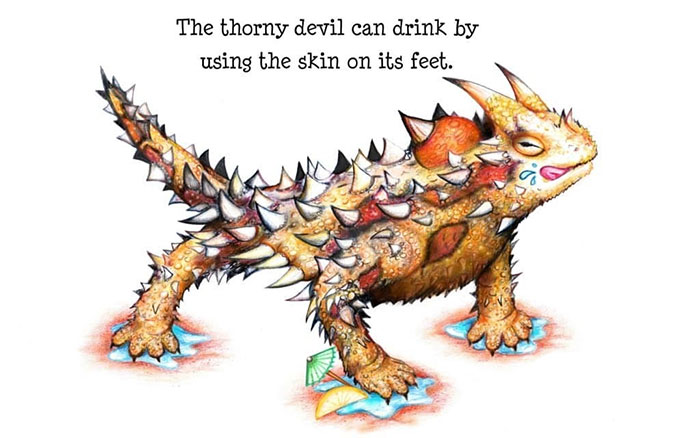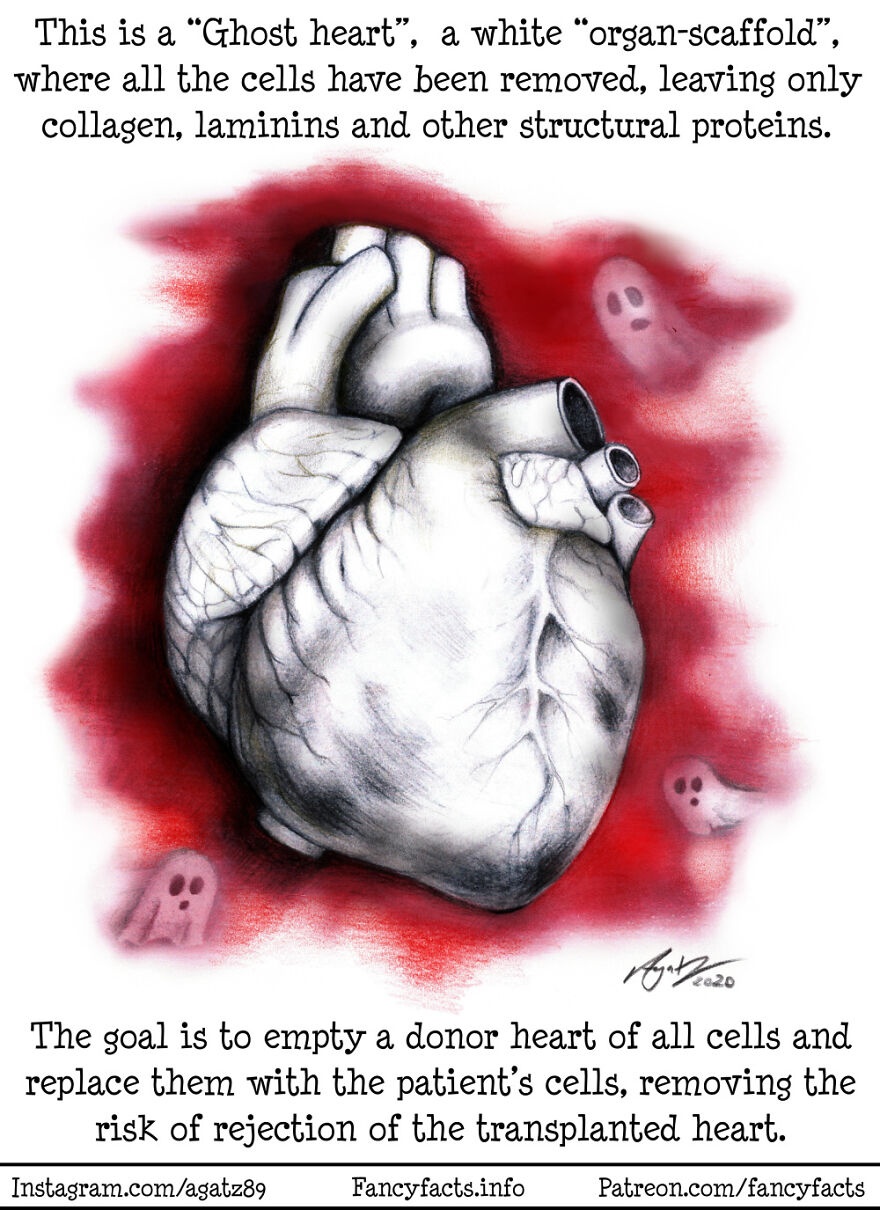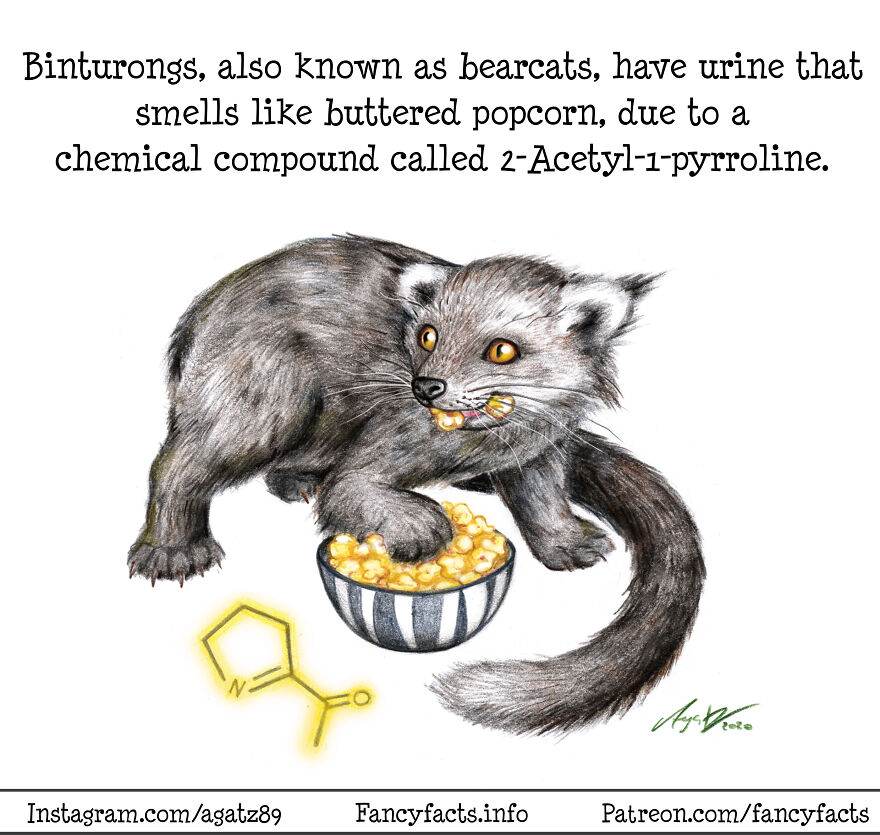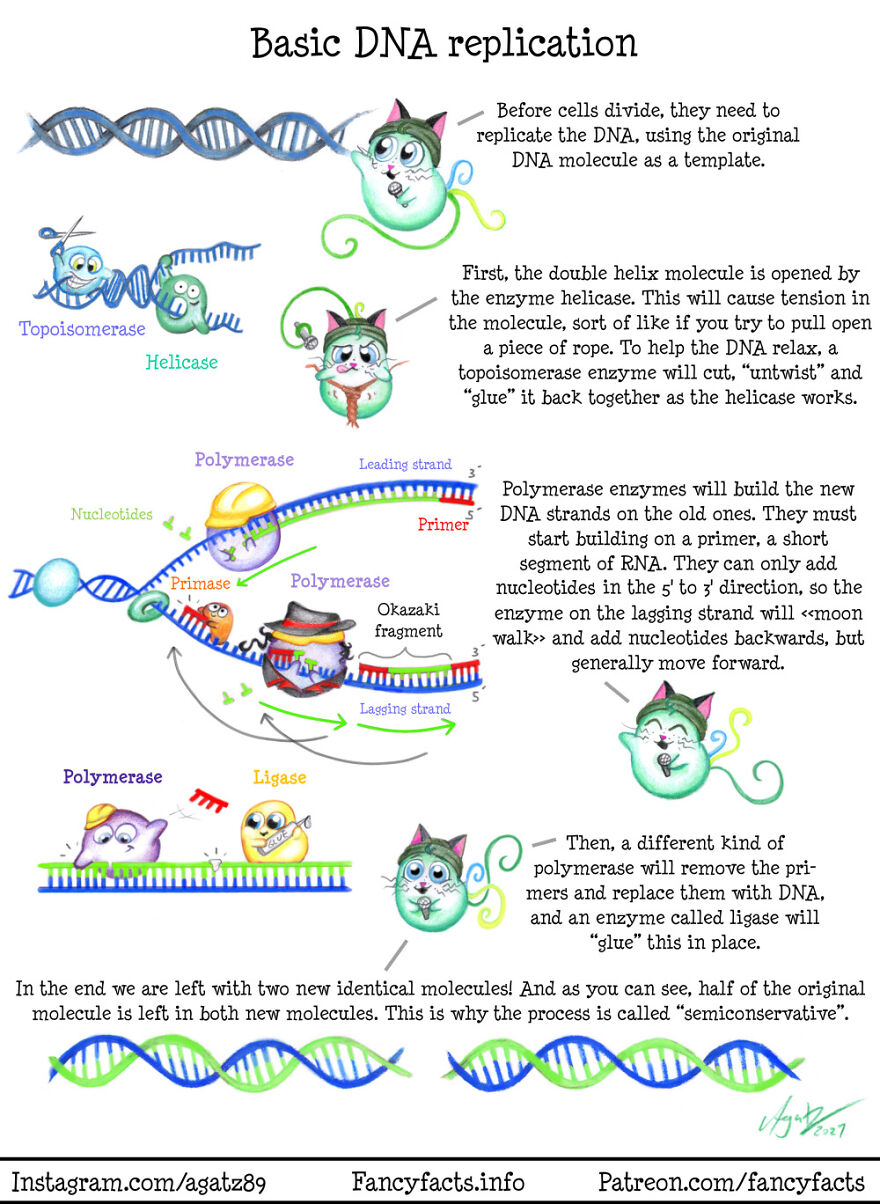
26Kviews
Here Are My 21 New Interesting Scientific Facts Illustrated In An Understandable Way
Here are 21 new hand-drawn illustrations of various facts. I make FancyFacts because I think colorful illustrations make learning more fun, even when it’s a little dry and relevant for school. I also include reliable sources, so everyone can read more if they want to, and so they know that these are actually facts, and not just something funny I heard at a bar once.
The last time I got featured here, your response was so nice, and I have really been looking forward to making a new post. The internet is usually a mean place, but Bored Panda is like a safe haven, and I just love it here.
I make most of the FancyFacts publicly available, especially things that are relevant for school, because I think that important facts should be free and available for everyone. Some are Patreon-exclusive and are supposed to be available to patrons only, but I have included a few of these in this post too, because I love this place, and I think you pandas deserve a little extra for being so nice. You can find my previous posts here and here.
To see more existing and future FancyFacts, visit my page and/or support FancyFacts on Patreon. You can also follow FancyFacts on Instagram.
More info: Instagram.com | Instagram.com | patreon.com
This post may include affiliate links.
Ghost Heart
The donor heart does not actually even have to be human. Science is awesome! Learn more in this easy-to-read article from Nature: Maher "Tissue engineering: How to build a heart."
This is an amazing process rife with almost unimaginable challenges.
Rod Of Asclepius vs. The Caduceus
You could really take your pick of sources with this one, but I liked this article: Shetty A, Shetty S, Dsouza O. Medical Symbols in Practice: Myths vs Reality.
Thorny Devil
It might be thorny, but it does not need to be thirsty. This is thanks to “their microstructured skin surface, with channels in between overlapping scales, [that] enables them to collect water by capillarity and passively transport it to the mouth for ingestion.” Article: Comanns et al. (2017) “Adsorption and movement of water by skin of the Australian thorny devil (Agamidae: Moloch horridus).”
Rat Drivers
The scientists constructed a little car the rats could enter and control by touching some metal wires to either turn or drive forwards. They found that not only could rats be trained to drive in fairly complex patterns, but learning to drive lowered their stress levels. The treatment group actually seemed to enjoy the task as they continued to drive even after they no longer received rewards for completing the task. The control group was harder to train and didn't drive as well as the treatment group.
What they actually studied was the effects of "enriched environments" on lab animals. An enriched environment is a housing environment (in the lab), that mimics the animals' natural habitat more closely than a standard lab cage. The treatment animals lived together in a multi-level cage with different objects/toys that were changed weekly to provide variety. In this case, the enriched environment was similar to how a pet rat might live in someone's home, as opposed to how lab animals usually are shown to be living in movies and TV shows.
Rats are often used as models to study how the brain works, both in medicine and in psychology. Knowing how the environment affects rats can help us understand how similar environments affect humans, as well as how to design better rat-based studies. Since rats can learn tasks as complex as operating a motor vehicle and navigating to where they want to go, scientists can use them as models for human behavior in even more complex situations in the future.
Newscientist has written a news article about the study with some really cute videos of the rats driving around.
The full study is: Crawford, L.E. & Knouse, L.E. & Kent, Molly & Vavra, D. & Harding, Olivia & LeServe, D. & Fox, N. & Hu, X. & Li, P. & Glory, C. & Lambert, K. (2019). Enriched Environment Exposure Accelerates Rodent Driving Skills. Behavioural Brain Research. 378. 112309. 10.1016/j.bbr.2019.112309.
Mimic Octopus
Of course, it does not actually mimic a virus, but it can mimic scary poisonous creatures like a lionfish or a sea snake. Mimicry is not really new in nature, like when a fly has evolved to look like a bee, but this octopus can choose to suddenly mimic something, and then immediately change to something else. It is so very cool.
Learn more about this funny creature from National Geographic, and take a look at photos of their actual mimicking here: National Geographic "Mimic Octopus", Alger "The Mimic Octopus: Master of Disguise".
Ethanol
I was just looking at a model of an ethanol molecule in my liquor cabinet and thought this would be funny.
Take a look at the chemical and physical properties of the ethanol molecule here.
Because those hydrogens don't want to have anything to do with each other and shift away from the carbon with the alcohol group.
Load More Replies...Parrotfish
Some large parrotfish species can poop up to 405 kg of sand each year. Although estimates vary, it's clear that they can produce a lot of sand. Perry et. al (2015) found that up to 85 % of new sand on a beach in the Maldives was made by parrotfish.
Read more:
Morgan and Kench (2016) "Parrotfish erosion underpins reef growth, sand talus development and island building in the Maldives"
Perry, Kench, O’Leary, Morgan and Januchowski-Hartley (2015) "Linking reef ecology to island building: Parrotfish identified as major producers of island-building sediment in the Maldives"
Glenn Roberts Jr "X-Rays Reveal the Biting Truth About Parrotfish Teeth"
You mean to tell me that when my misses said my sand castle was s**t, she was right?
Blue Whale
These things are huge... I guess we all knew that, but that tongue thing is impressive. Read more about blue whales and their size at BBC earth: Connor "The anatomy of a whale."
Evolutionary Moths
This is a cool example of how evolution works.
During the industrial revolution, coal-powered plants turned tree trunks and nesting places of peppered moths darker. This led to a rapid increase in the proportion of dark (melanistic) moths, as they had better camouflage than their more light-colored family members and were, therefore, less prone to be eaten by birds.
Today, the process is reversed, as fewer plants are coal-powered and three trunks are turning lighter again.
Read about it here: Cook, Grant, Saccheri and Mallet (2012) "Selective bird predation on the peppered moth: the last experiment of Michael Majerus."
Taxomnemonic
I made this mnemonic, so I'm not adding a source to that, but you can read more about taxonomic ranks here: Lumen, Biology for Non-majors 1 "Taxonomy."
(Yes, I am aware of what Pierce says in Community. But I'm not illustrating that)
Thawing Food
It sure is tempting to speed up the process, but why risk it?
If you want to read more about this topic, I found that WebMD had a very nice and easy-to-read slideshow of what you should and should not do regarding defrosting.
Zelman "The Cold, Hard Truth About Defrosting"
https://www.webmd.com/food-recipes/food-poisoning/ss/slideshow-cold-hard-truth-about-defrosting
Bearcat
House training puppies would be easier if all animals smelled like this. Anyway, enjoy further reading about the bearcat (who is neither a bear nor a cat btw) at trusty National Geographic: Langley "Why This Animal's Pee Smells Like Hot Buttered Popcorn."
A Friendly Reminder To All Students
I suppose this is a bit different from the usual FancyFacts, but I feel it is important. Even though I enjoyed university, I spent a lot of time throwing my books at the wall. And it is very hard for someone to see how much time it took me to understand something when all they see is the A on my final exam.
I also have to say that even though it was hard, it was worth it, but it won't get easier for anyone if people refuse to admit that they can struggle with something. That will just make people feel alone. You are not alone.
And also: you can have learned a LOT even though you don't get an A, exams are not everything. The most important thing is that you learn and that you learn how to learn!
Zombie Ants
Nature is cool and creepy. The fungus wants a place with the right humidity and the right conditions for spore dispersal, and it wants a snack. It achieves all of this by hijacking a poor ant, forcing it to leave its home and follow the directions of its infection. At the right place, it will bite down on its spot to stay put, and there it will die, allowing the fungus to sprout up and continue its life cycle. Read more about this jerk, and watch a video at National Geographic: Lu "How a parasitic fungus turns ants into 'zombies'".
Venomous Snail
These snails have a very complex venom that is among the most deadly venoms for humans, rivaling several of the most venomous snakes. However, scientists have also started exploring potential medicinal uses for various parts of the venom.
Articles:
Dutertre et. al. (2013) "Deep Venomics Reveals the Mechanism for Expanded Peptide Diversity in Cone Snail Venom"
Dutertre et. al. (2014) "Intraspecific variations in Conus geographus defence-evoked venom and estimation of the human lethal dose"
Cone snails also tend to have very pretty shells. Some divers make the mistake of picking them up and getting envenomated (which they can do very fast).
Poop Coffee
I mean... I don't even like coffee, so this is probably not for me. Also, I do not have US$1300 for wild-collected beans. But if I were to try it, I would definitely pay more to get the wild type. Caging these animals for profit is a big no. If someone loves poop coffee they should respect these cuties, they are the poop heroes after all.
Read more here, here, and here.
I've always wondered just how caffeine deprived would you have to be, to be the first person to look at civet poop covered coffee beans and think " Well, alrighty then"
Resistant Target!
They sure are sneaky little things. This is just one example of how bacteria can resist antibiotics. Read more in one of my favorite articles: Reygaert (2018) "An overview of the antimicrobial resistance mechanisms of bacteria."
This one gets even better: Bacteria are also known for exchanging genetic material between them, to some extent even between similar species - without generational change no less (i.e. between living cells that continue to then live and replicate using changed genome, passing changes to next generation of cells). Which can lead to even more antibiotic resistance, among other things.
Basic DNA Replication
To learn a bit more, I would recommend Khan Academy "Molecular mechanism of DNA replication."
Stem Cells
One of the best things about doing FancyFacts, is that I have a good reason to jump back into really old lessons. When people finish university and start working, it is easy to lose a lot of the basics. People usually don’t need everything they have ever learned during their education... But I do. Now almost everything is relevant, from every class from every year, I get to not forget all the cool things I have learned. It is awesome!
If you want to read a little bit more, I found a nice and easy article about this from Library of congress.
Impressively, the ovaries do not develop new ovarian follicles after birth, i.e. the full ovarian reserve a women has for her lifetime is developed while she herseld developes as a fetus. (Source: https://embryology.med.unsw.edu.au/embryology/index.php/Ovary_Development#Fetal_Ovary)
Telomers And Telomerase
This one was a bit more challenging than other FancyFacts. When explaining telomers and telomerase it is easy to explain it so simply that what is being explained is not actually accurate, and that leads to misunderstandings. But this is a complex matter, and explaining it too thoroughly just ensures that people don't find it interesting. I spent a lot of time trying to find the balance here, so I have spent a lot of time with some of my old books, in addition to this article: Hiyama, E., & Hiyama, K. (2007). Telomere and telomerase in stem cells.
On Patreon and my web page, I included pictures of the pages in the books I used, so that no one has to search for and buy expensive books for a couple of sentences.
Thank you. Many things I've wanted to know about and how to find out more.
From Sugar To Energy
There is no way to fit all of the complex processes onto one A4 page, but I wanted to illustrate an overview that shows how these fit together. The electron transport chain got a bit more complex than I intended to. I guess I'm so very used to drawing this on exams, so I didn't think about it before it was done. But then I thought, hey, that is where most of the energy is produced, so why not.
If you want to learn more about the different processes, I would suggest looking here, here, here, here, and here.
Frankly, I would like to see on BP much more of such schience-embracing posts, along with puppys and kittens and with art than all those recent collections of infuriating social media posts.
I don't understand 3/4 of these (but I try) and I'd also prefer these over social media posts. At least these are fun and educational.
Load More Replies...That was so interesting that my teenage son actually read it all! It takes a grand amount of talent to keep him interested in anything that isn't a video game. Thanks!
Making learning and science interesting and fun like this can reach more students who find such topics difficult to understand. I love the illustrations.
You are doing great job! I definitely won't forget my molecular biology any time soon. And btw. you could probably make some more about immunology, that's my favourite school subject and I think it's fascinating.
I added 20, boredpanda added another (they asked me, btw) so it will probably be fixed soon :) I promise I can count, lol :p
Load More Replies...Frankly, I would like to see on BP much more of such schience-embracing posts, along with puppys and kittens and with art than all those recent collections of infuriating social media posts.
I don't understand 3/4 of these (but I try) and I'd also prefer these over social media posts. At least these are fun and educational.
Load More Replies...That was so interesting that my teenage son actually read it all! It takes a grand amount of talent to keep him interested in anything that isn't a video game. Thanks!
Making learning and science interesting and fun like this can reach more students who find such topics difficult to understand. I love the illustrations.
You are doing great job! I definitely won't forget my molecular biology any time soon. And btw. you could probably make some more about immunology, that's my favourite school subject and I think it's fascinating.
I added 20, boredpanda added another (they asked me, btw) so it will probably be fixed soon :) I promise I can count, lol :p
Load More Replies...
 Dark Mode
Dark Mode 

 No fees, cancel anytime
No fees, cancel anytime 




















































































